Just as water retains no constant shape, so in warfare there are no constant conditions. He who can modify his tactics in relation to his opponent and thereby succeed in winning, may be called a heaven-born captain
Sun Tzu, The Art Of War
In a league where the total market value is 9.74 billion, even mid-range teams have elite level managers, and the tempo never drops, how can you achieve dominance over opponents as a team that plays almost every three days? I think Pep Guardiola has been answering this question since he arrived at Manchester City. The "blues," who have celebrated championship in the Premier League four times in six years since Guardiola took charge of, are also competing for the championship this year with Arsenal, a team well-known to Guardiola and coached by Mikel Arteta, after a strong start to the league. We can't know if Manchester City will lift the cup for the third time in a row, but they will certainly challenge their opponents in the process. So what makes this team special, and why do they dominate most of their matches? Let's explore this question based on some of Manchester City's matches this season.
West ham 0-2 manchester cıty / 07.08.2022
Inverted full-back. Similar roles to a inverted full-back, which take position in midfield rather than on the wings when the team is in possession, have appeared throughout football history, but the role's first use in modern football at an elite level dates back to Pep Guardiola's Bayern Munich years. The ability of Guardiola's opponents in Germany to quickly advance the ball towards the opposing goal after intercepted passes prompted him to come up with such a solution, and he introduced the concept of the inverted full-back to us with players like Alaba and Lahm.
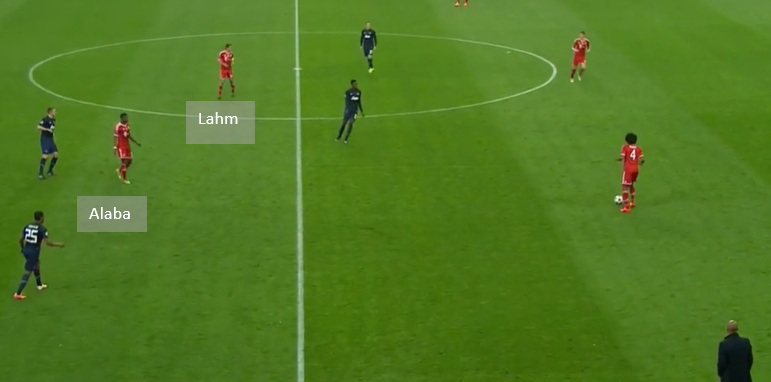
Guardiola, who has often used this role since coming to England, also benefited from it in the opening week of the league, but another aspect of the inverted full-back left a mark on the match as a whole: the ability to manipulate the opponent. The lineups in the match in which their new transfer Erling Haaland made his debut in the league were as follows:

From the 4th minute of the match, we saw J. Cancelo and K. Walker come inward from the wings while Man. City was in possession in the middle third. The interesting thing here is that normally teams draw the opposing full-backs inward and open up space for their wide full-backs in the attacking third. Manchester City, however, pinned the opposing wingers to the center while the team was still in the build-up phase and opened up a direct pass channel to Grealish and Foden on the wings. The reason the opposing full-backs were unable to aggressively follow Manchester City's wingers in these and similar positions was due to De Bruyne and İlkay positioning themselves between the centre-backs and fullbacks. If the full-backs followed the wingers, there would be huge gaps, which could be exploited by Kevin De Bruyne and İlkay Gündoğan. Therefore Manchester City's wingers frequently found themselves with the ball.

When the opposing full-back followed Grealish and Foden, the wing player on the other side of the pitch was left open due to West Ham's inability to make match-ups, and Manchester City frequently tried to take advantage of this situation with diagonal passes throughout the match.

Grealish sends a long ball to Foden

As a result of the full-back going forward, the player on the opposite wing is free once again.
Another advantage of this formation was that it also provided defensive security. Manchester City is one of the best teams in the world at implementing "rest-defense", which means that the team in possession is prepared for a potential turnover, before they even lose the ball. The rest-defense, which is used by many possession and gegen-press based teams, also appeared in this match. If Manchester City had lost the ball in situations like the one in the following image, they could quickly press with 5 players or redirect their opponent to the wings where they could create less threat.


The fullbacks are wide, so if the opponent takes the ball, they can quickly attack from the center.

The full-backs position themselves inside, so the opponent can only advance through the wings, which means that the distance to Manchester City's goal is much longer for the opponent

In this situation, Rodri loses the ball

Manchester City players quickly redirect their opponent to the wing and prevent the possible counterattack
Before Manchester City scored their first goal, we saw how the position changes among the players disrupted the opponent's defensive structure.

Cancelo leaves his own area and enters Ilkay's area

Ilkay recognizes the gap and fills the open space

Soucek follows Ilkay but Bowen does not follow Cancelo, so Cancelo is left open

Rodri delivers the ball to Cancelo

Bowen doesn't follow Cancelo, so Soucek leaves Ilkay and goes to Cancelo, leaving Ilkay open. Ilkay runs forward to create a passing option and receives the ball
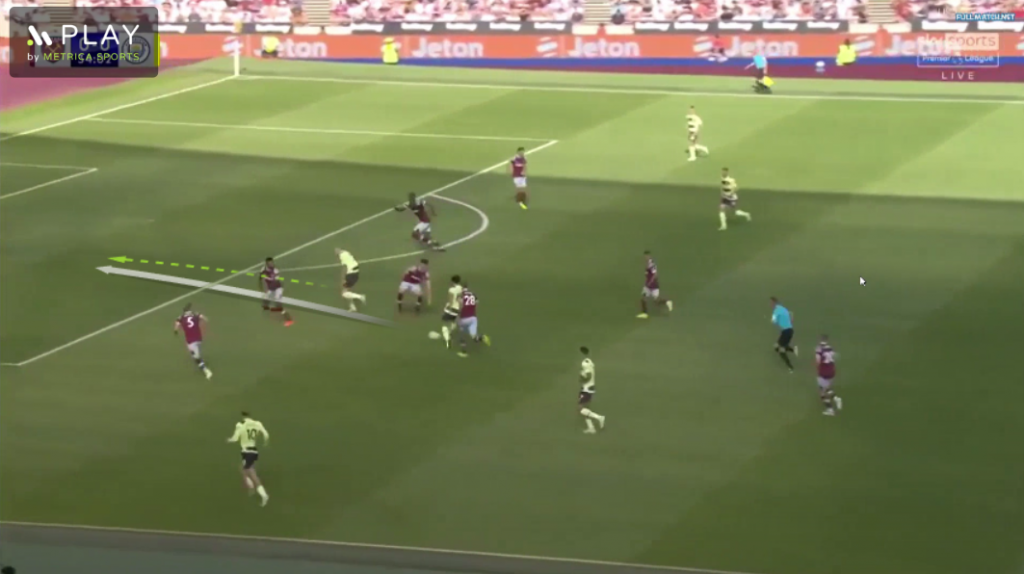
Haaland uses his athleticism to run behind the defensive line and receives the ball, earning a penalty kick for his team
In these situations, the players' scanning ability is very important because if Ilkay had not noticed that Cancelo had left his position and taken advantage of the gap, this opportunity would not have arisen.
How victory may be produced for them out of the enemy's own tactics--that is what the multitude cannot comprehend
The Art Of War
Manchester Cıty 4-0 Bournemouth / 13.08.2022
Numerical superiority. Manchester City has a very flexible structure in terms of tactics, even though they never give up on their philosophy of play. In particular, they adjust the number of players they have in the front line according to the number of defenders of the opponent in order to find spaces in opponent's defense. Manchester City, who lined up in a 2-3-5 in the final third against West Ham's 4 defenders, played against a 5-man defense in this match but did not give up on their +1 rule and formed a front line of 6 players. In other words, it is possible to say that Guardiola tries to create numerical superiority in different ways against different opponents.

Due to the numerical superiority of 6v5, Cancelo is open
While Mahrez takes a position on the right touchline, Cancelo is the player who gives width on the left, unlike the West Ham match. With Walker and Rodri taking positions in front of the center backs, creating a "rectangle" rest-defence structure, Manchester City also ensured defensive security in this way.

2-2-6
The home team's first goal also came from the players' high-level scanning and ability to exploit gaps. While trying to disrupt Bournemouth's solid 5-4-1 structure throughout the match, Manchester City achieved this in the 17th minute with Cancelo's back pass.

Lewis Cook follows Ake's back pass to Cancelo

As a result, a gap is created in Bournemouth's midfield and Ilkay positions himself in this gap

Since the passing channel to Ilkay is closed, Ake passes the ball to Walker. As seen from Haaland's hand signal, Walker has a open passing channel to Ilkay and uses it

Ilkay calmly passes the ball to Haaland and continues the run. The position ends in a goal as a result of Haaland's return pass
Without the ball, we saw Manchester City's usual high-press to force the opponent to play long. The defenders' dominance in the air also helped them to quickly regain possession.
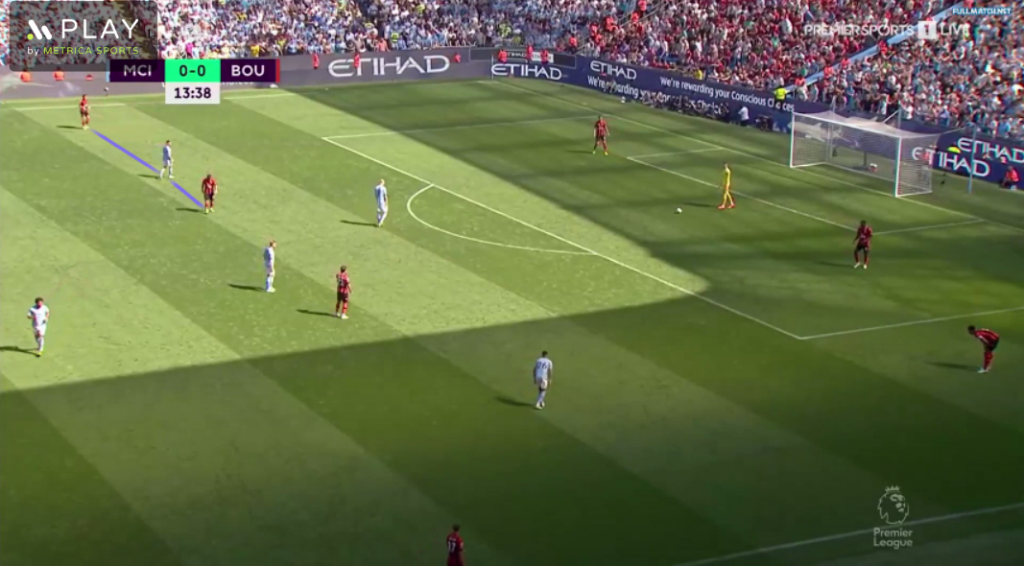
When Manchester City players go to press in a 4-2-3-1 formation, it is notable that one of the wingers marks opponent's fullback man-to-man, while the other stays between the full-back and the midfielder

When the goalkeeper played his first pass, it was important for Haaland to disrupt the connection between the defender with the ball and the goalkeeper, while also applying cover shadow to Ben Pearson
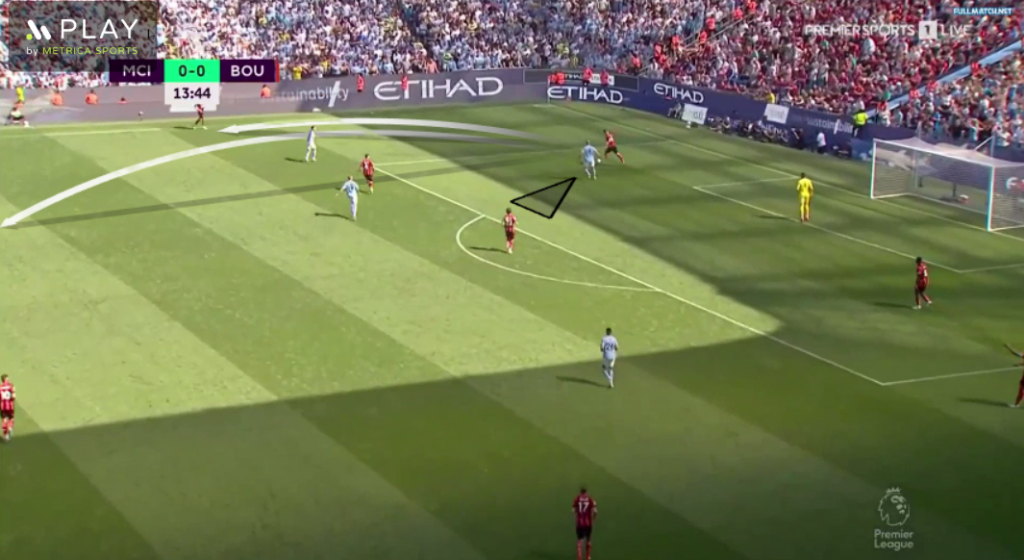
De Bruyne also marked closely the right center midfielder, leaving only two options for C. Mepham: play long or pass to the right wing-back

Mepham chose the first option, but the Manchester City players achieved their goal and aggressively pressured to regain possession
Manchester City manipulates their opponents, not only when they have possession, but also when they don’t through conscious and preplanned pressing. Using the philosophy of Manchester City's coach's mentor Johan Cruyff, to narrow the field as much as possible when the opponent has the ball, the team forces their opponent to play to the wings and then aggressively presses to regain the ball or forces the opponent to play long balls and chases the second balls.
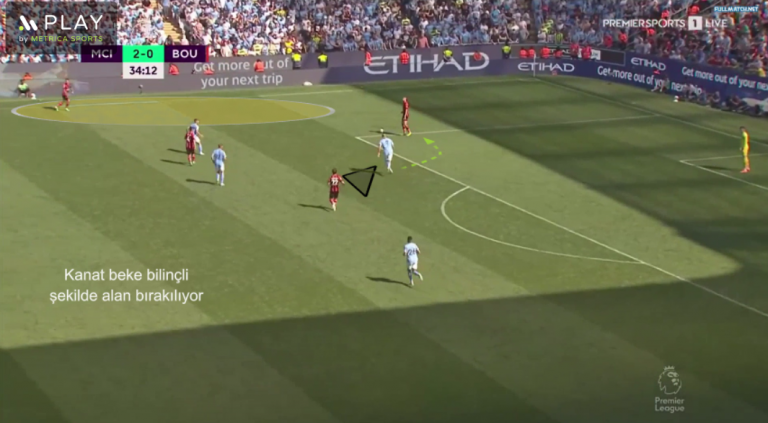
This match was also Erling Haaland's second Premier League match. In this match, although he only touched the ball eight times, Erling Haaland helped Manchester City in another way by providing depth and opening space for his teammates.
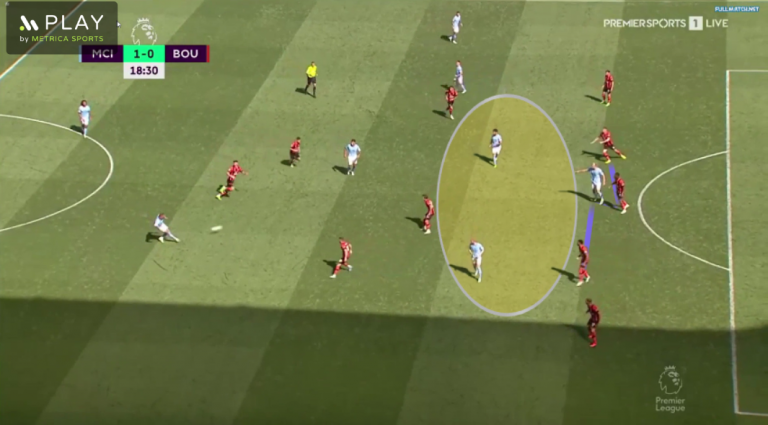
As can be seen in the first goal, Bournemouth defenders drop back in fear of Haaland's ability to drop behind the defence, resulting in large spaces between the lines for De Bruyne and Ilkay to exploit. The situation ultimately resulted in a goal.
In this image from the Manchester City versus Crystal Palace match, Manchester City is lined up in a 2-2-6 formation, similar to the Bournemouth match, with Walker coming to the center:

Newcastle unıted 3-3 manchester cıty / 21.08.2022
But why does Manchester City concede so few goals, despite not playing with defense-oriented lineups? They are extraordinary in both attack and defense, looking at their games in general there is a very obvious reason: they attack slowly. Because they attack slowly, City players who are prepared for a potential turnover before they lose the ball are able to regain the ball by applying ''gegen-press''. In other words, they see the attack and defense as interconnected pieces rather than separate from each other. This is what they did not do in the Newcastle match. Throughout the match, City tried to develop quicker and more direct attacks than usual, they could not set up the rest-defence structure. As a result, they left a lot of space behind after losing possession. On the other hand Newcastle has one of the best transition players in the world who can make the most of these empty spaces: Allan Saint-Maximin. Unsurprisingly, Saint-Maximin caused quite a lot of trouble for Manchester City's right wing throughout the match. Recognizing the problem in the match, Guardiola did not fail to mention this after the match: "We should spend more time in the final third, give more passes, but it’s difficult because Erling is going, Phil has this aggression to go. If Jack (Grealish) plays there or Riyad (Mahrez) or Bernardo (Silva) play on the right, they are more calm and they help us to be all together. And when we lose the ball, we are there and they (the opponents) cannot run. We didn't slow down and pass, which allowed them (the opponent) to attack with Maximin". As can be seen, different players have different tendencies and it is the manager's job to blend them together in the best way. Some players want the ball at their feet, some want it in the open space in front of them and make aggressive runs. Both types of players should be present in a team. For example, if a team does not have a player who can aggressively run behind the defence, that team cannot provide sufficient depth and narrows the space they have, making their attacks more difficult. One of the reasons why Manchester City puts so much pressure on their opponents is because they use both types of players in a way that serves their goals.
The objective is to move the opponent, not the ball
Guardiola
One of the other important aspects of Manchester City is their sudden diagonal passes to the opposite wing. After the build-up, City draws the opponent to one side of the field with short passes and then, when the winger on the opposite wing finds enough space, they reach him with a diagonal long pass. From this point on, the winger, who has caught the opponent unprepared, takes the ball to the final third and looks for ways to score. This same pattern can be seen in this video of Manchester City's U16 team being trained by Ilkay Gundogan:
This scenario also occurred in the Newcastle match and the away team scored their first goal in this way:

Manchester City players overload the left side of the pitch and draw the opponent to themselves with short passes. Then, Bernardo Silva receives the ball on the opposite wing through Ilkay's long pass and takes advantage of the open space in front of him

While Newcastle United's defenders has not yet fully settled into their position, Ilkay finds the net through Bernardo's cross
Wolverhampton 0-3 Manchester Cıty / 17.09.2022
In the 8th week of the league, Manchester City, who were the guests of Wolverhampton, found the goal with De Bruyne's classic cross to Grealish in the first minute of the match. City, who got the upper hand early in the match with Nathan Collins' red card in the 33rd minute, returned home with 3 points with a 3 goal difference. What stands out here is Manchester City's flawless build-up. The contribution of wingers' wide positions to the build-up demonstrates that all the players in the team, not just the defensive players, are involved in the build-up.
Wolverhampton's wingers applied pressure on Manchester City's centre-backs in a style similar to Liverpool, and tried to apply cover shadow to the opposing full-backs while doing so, but the large distance between Manchester City's centre-backs and fullbacks didn't allow this to happen. When Cancelo received the ball in a wide area, the opposing right full-back did not press him. (because Grealish pinned the opposing right full-back)

Subsequently, Matheus Nunes, Wolverhampton's number 8, left Bernardo and pressed Cancelo, but Bernardo received the ball with a blindside run

Bernardo exploited the empty space in front of him and Manchester City created a goal chance. From this picture, it is also understood how Grealish pinned the opposing right full-back


This time, Ederson is the one who passes

Matheus Nunes' press on Cancelo leaves Bernardo as the open player once again
Manchester Cıty 6-3 Manchester unıted / 02.10.2022
"Noisy neighbours". These are the words used by Sir Alex Ferguson to describe Manchester City. Looking back, the reds have been ahead of their opponents, but in recent years the blue side of the city has been superior. Manchester United, wanting to reverse this situation with their new manager Erik ten Hag, was the guest of Manchester City at the Etihad Stadium in the 9th week of the league. However, the away team couldn't respond in the first half and entered halftime with a shocking score: 4-0. Although the second half score was in favor of the away team, with a score of 2-3, the match ended with a 6-3 Manchester City victory. So, how did Manchester City benefit from Manchester United's press pattern and find goal scoring opportunities?
The first thing that attracts the attention was Manchester United's pressing with a 4-2-3-1 formation. As a result, Manchester City defenders, Ake and Akanji had a 2v1 numerical advantage over Rashford

The away team tried to counter this by sending their wingers to City's centre-backs, but this left Cancelo and Walker open. The City full-backs were able to receive the ball in wide areas throughout the match due to the technical skills of their teammates
Antony leaves Cancelo and put pressure on Ederson, but Ederson uses his high passing ability to pass the ball to Cancelo

Ederson once again. This time the pass is received by Walker. Manchester United's man-to-man marking in the midfield is also noticeable

Ederson once again demonstrates the contribution of a modern goalkeeper to build-up and calmly passes the ball to the space left open by Antony

If Manchester United's wingers don't press, this time the home team's centre-backs are left with open space. Ake and Akanji made good use of these areas, constantly attempted dribbling and moved the ball into the third zone. Here, the Manchester City players' movements were also crucial. The City midfielders, noticing that their opponents' midfielders were constantly marking them man-to-man, lured them to areas where the Manchester United midfielders couldn't apply pressure on City's centre-backs instead of running towards the defenders to receive the ball, creating both space and time for the centre-backs

While Rashford closes the passing channel to Ake, Haaland drops to the midfield with a false-nine-esque movement and finds Ake, the third man

Rashford is too far from Ake so Bruno Fernandes goes to press, but Ilkay makes a run into Bruno's blind spot and receives the ball

Ilkay carries the ball into the final third and passes to the isolated winger on the left

In this situation, Rashford tries to cut off Ake's connection with the other side of the pitch, but Ake uses the open space in front of him and dribbles

As Ake approaches the midfield, De Bruyne runs towards the wing, dragging McTominay with him and creating more space for Ake to use

A 2v1 numerical superiority is gained against McTominay. When McTominay tries to intercept, Ake plays it to De Bruyne, who carries the ball into the final third
- The 3. goal, like in other situations, comes from Manchester City players taking advantage of Manchester United's man-to-man press in midfield. It's possible to say that there was also a mistake made by Manchester United's right back Diogo Dalot in this goal because he doesn't follow Jack Grealish, who moves into the midfield.

While Manchester United's midfielders mark their opponents tightly, Grealish drops to midfield and creates a passing option and receives the ball in a wide area because he isn't followed by Diogo Dalot

Eriksen has to leave De Bruyne to go to Grealish. Seeing this, Grealish passes the ball to De Bruyne

De Bruyne makes one of the passes that we're used to seeing from him to half-space to Haaland and Manchester City scores their third goal with Haaland's shot
Another thing we saw constantly throughout the match was Bernardo Silva's runs behind the defence between the full-backs and centre-backs. There were often gaps between Diogo Dalot and Raphael Varane due to Jack Grealish's wide position. Bernardo made good use of these gaps and was difficult for McTominay to follow, allowing the home team to creating goal-scoring opportunities frequently.

Grealish pins D. Dalot to the touchline. Bernardo recognizes the open space and moves into it. Through Kevin De Bruyne's pass, the Blues get the chance to take the lead in the early minutes of the match

- In the 20th minute, the same scenario occurs in the final third. Bernardo takes advantage of right full-back's momentary hesitation and receives the ball in the half-space to cross, but Foden can't score
As can be seen, man-to-man defence may not be very logical against a team with such a high level of positional play, even if Manchester United only applied it to their midfielders. The players' game intelligence and their ability to easily change positions make it difficult for their opponents. In build-up, the defenders and goalkeeper Ederson have above average technique, the wingers stay wide and high, which causes large gaps between the lines of teams trying to press high.
Manchester Cıty 4-0 Southampton / 08.10.2022
Exploit the space. If there is no space, create it yourself. When we look at Manchester City's games, we see that their aim is actually quite simple when moving the ball to the final third: to reach the open player. As can be seen in the upper sections of this article, this open player can vary depending on the opponent's pressing shape. But what if there is no open player? Then you create it yourself. Just like in the match against Southampton.
Although the two teams are on paper in these formations, we did not see Manchester City's 4-2-3-1 formation during the match, but rather a structure trying to reach Cancelo, the open player, with the ball.
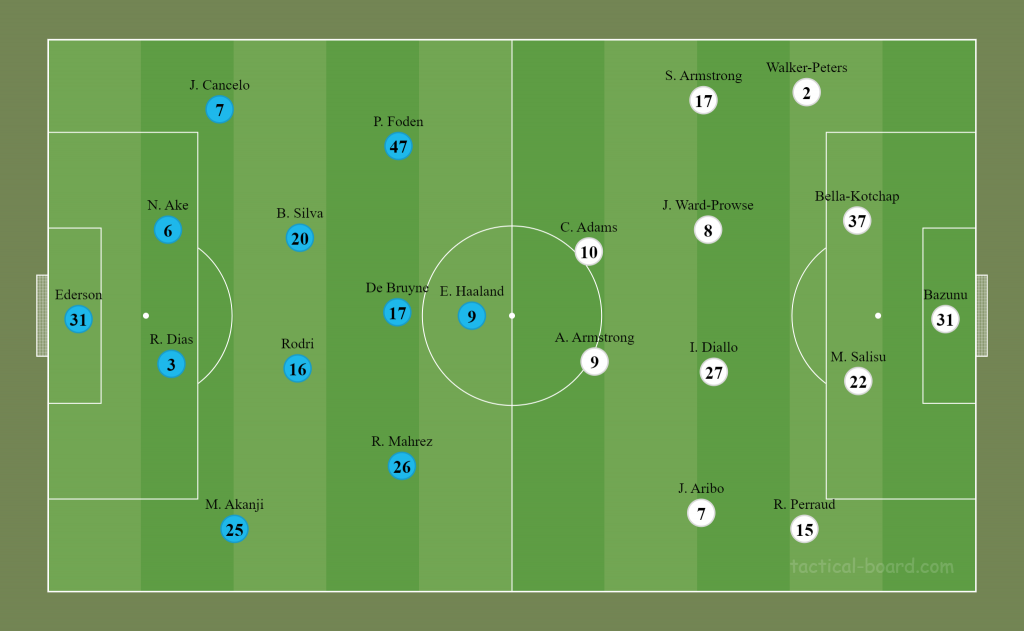
It is not a coincidence that we see that the Blues used the left side of the pitch more when we look at the attacking direction of the two teams after the match. Manchester City had a 3v2 numerical superiority in build-up against Southampton, who pressed in a 4-4-2 formation. With Ederson, playing like a centre-back and Cancelo's more advanced position, it created space for the front players in this way. Let's look at how they did this with some images from the game.

In this situation at the 5th minute, we see Ederson playing like a left centre-back, which allows Cancelo to advance. Cancelo's position is important as he positions himself between the opposing right winger and right full-back, creating time and space for himself

The opposing right full-back, Walker-Peters, is unable to adjust the timing of his press (also due to Cancelo's positioning) and as a result, there is enough time for Cancelo to deliver a pass towards the front. With a third man combination, Bernardo Silva is able to receive the ball with his face towards the opposing goal and the first pressing line is broken. After making the pass, Cancelo aggressively runs forward and receives the ball again, but the chance is not well utilized. At the same time, the Southampton defenders, shifting towards the right side of the pitch to cover the space left by the right full-back, leave Mahrez open on the other side

In order to prevent the numerical superiority of City defenders against the opposing forwards, Southampton's right winger, S. Armstrong, often had put pressure on Ake. As can be seen in the image, when Armstrong leaves Cancelo open, Ake signals to Ederson to pass to Cancelo

Cancelo receives the ball and directly carries it into the opposing half of the field

Similar situation, this time it is B. Silva who signals to Ederson
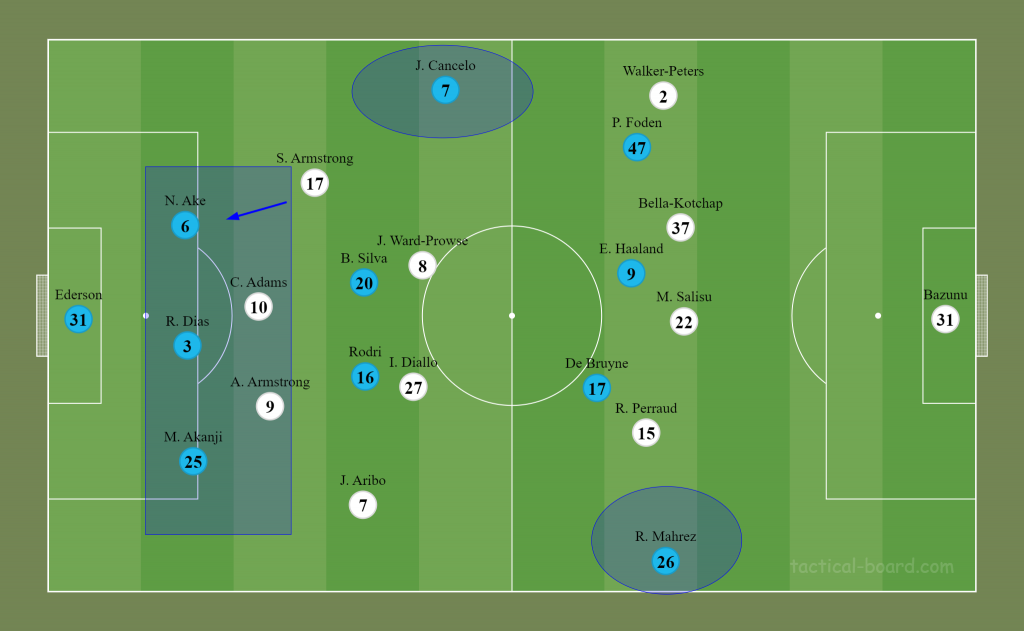
As you can see, communication between the players has an incredible impact in the ability to play a fluid game. While the signals above may seem simple, they contribute to the players' decision-making ability and make things easier for them on the field. It is also important for the players to lift each other up in this way during the match to avoid disconnection.
Finally, if we look at Manchester City without the ball, we see that they often face their opponents in a 4-4-2 formation, as they have done in many matches. With De Bruyne leaving the midfield and advancing to the forward line and the wingers dropping back, the closest player to the ball from the front duo puts pressure on the centre-back while also breaking the connection between the centre-back and the defensive midfielder, dividing the field and reducing the area that the opponent can play in.

On the left, De Bruyne applies cover shadow and blocks the passing channel to Diallo, directing the opponent to the left side of the pitch and reducing the number of passing options. By comparison with other pressing patterns, the goal is always to reduce the area that the opponent has as much as possible.
Manchester Cıty 3-1 Brıghton / 22.10.2022
Prior knowledge. Obtaining prior knowledge about opponents and analyzing past matches allows for better preparation and knowledge of what to expect. In today's football, thanks to technological opportunities, opponent analysis can be done much faster. That's why many teams try to make moves to surprise the opposing team. In situations where the opponent does not play as expected, it is important to quickly adapt to the situation and generate new solutions. A good example of this is the match played at the Etihad Stadium in the 13th week of the league. Brighton, which had not won any of their last 4 matches before the Manchester City match, made it difficult for their opponent in this match. Facing Manchester City, led by Pep Guardiola, whom their new coach Roberto De Zerbi is a fan of, Brighton showed from the beginning of the match that they were not going to be an easy prey for the home team. Instead of defending against the opponent in the defensive third, Brighton preferred to press high. They did this with a tight man-to-man defence, leaving only Ederson free. Guardiola, who humorously explained this situation after the match, said: "They (Brighton) went man-to-man. How do you make good distribution when you have a man follow you to the toilet? No space. Wherever you go, they come. The only player who could go to the toilet was Ederson. We had to play more direct to Erling"
Brighton gave us hints of the man-to-man defence they would play throughout the match in the first minute
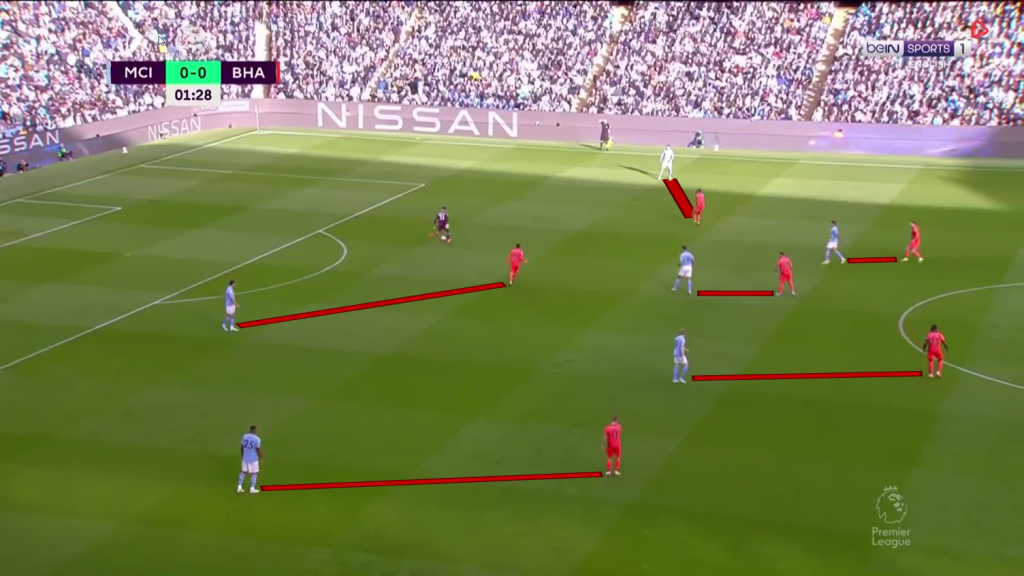
In the 6th minute, when Danny Welbeck was injured, the game stopped. Guardiola, who had already noticed the opponent's defensive approach, had found a solution. Ederson, B. Silva, E. Haaland and R. Dias were called and instructed by Guardiola in order to find space behind the opponent's defence and use the time and space that Ederson had. From this minute on, we saw Haaland drops to the midfield and the Brighton centre-back Lewis Dunk follows him all over the pitch. Manchester City's 8 (KDB and B. Silva) also started to run aggressively into the open space, and the momentum was on the home teams side.

Ten minutes after the game stopped and Guardiola gave his instructions, we see Haaland drops deep and Brighton's centre-back Lewis Dunk following him

The same logic applies here, but this time the players are different. Bernardo and De Bruyne's positions open up a direct passing channel to Haaland
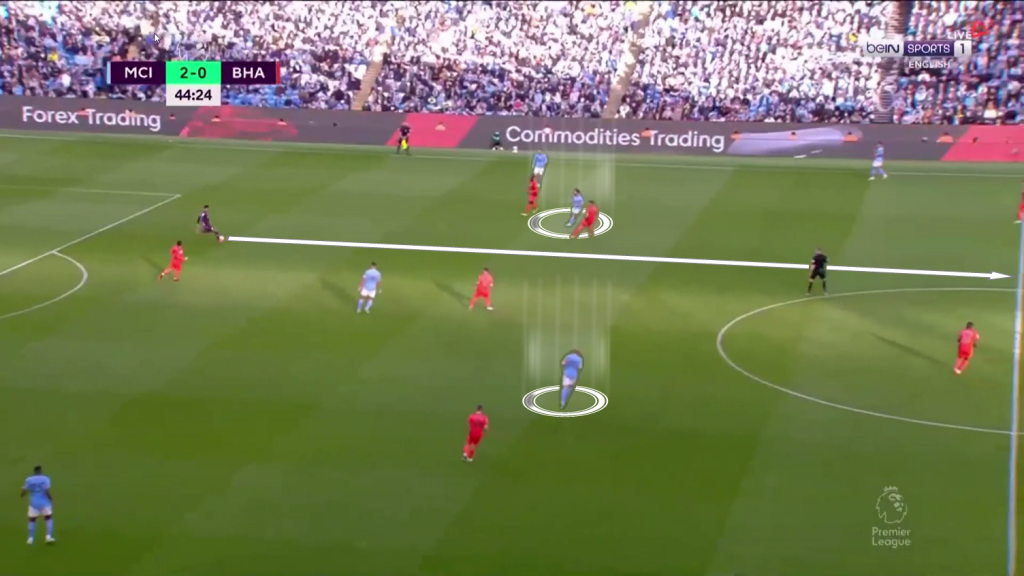
Bernardo and De Bruyne take deep positions, which also draws their markers. This opens up space for Haaland
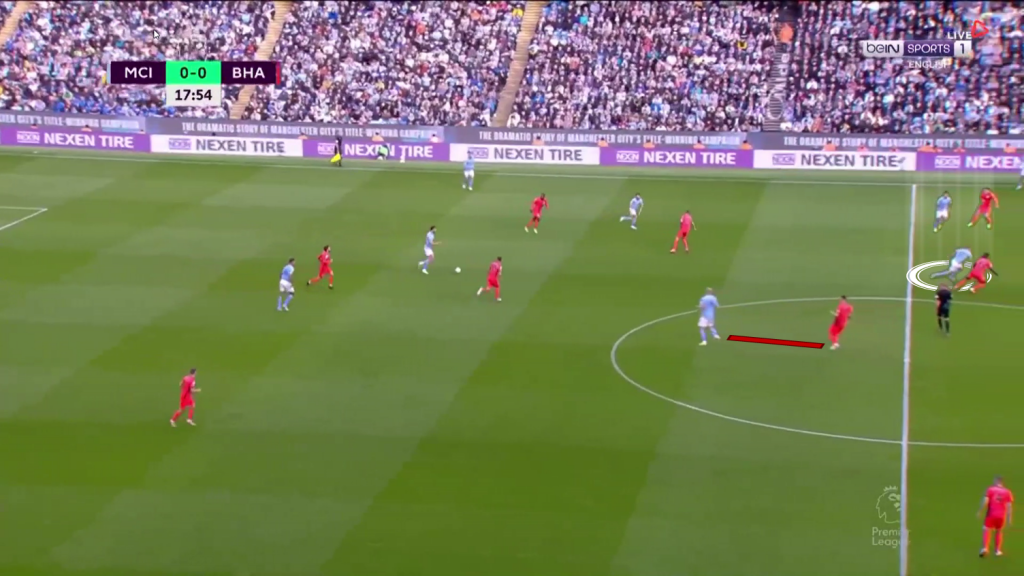
Another action we often saw in the match was De Bruyne's runs behind the defensive line. While the home team couldn't score from these actions, KDB could have faced the goalkeeper 1v1 after a through ball

In this situation, Haaland drops deep and sees KDB running into the space created by him, but he is unable to pass to KDB
Manchester City's first goal showed us how special of a player Erling Haaland is. In City's first goal, Haaland's athleticism alone was enough. He created space for himself and scored to give his team a 1-0 lead. The wide position taken by the wingers was also important. They pulled the 3-man defence's wide centre-backs to the wings and created space for Haaland.

Mahrez and Grealish pin the opponent's wide centre-backs to the wings and Haaland dropping deep opens up space where Lewis Dunk should normally be
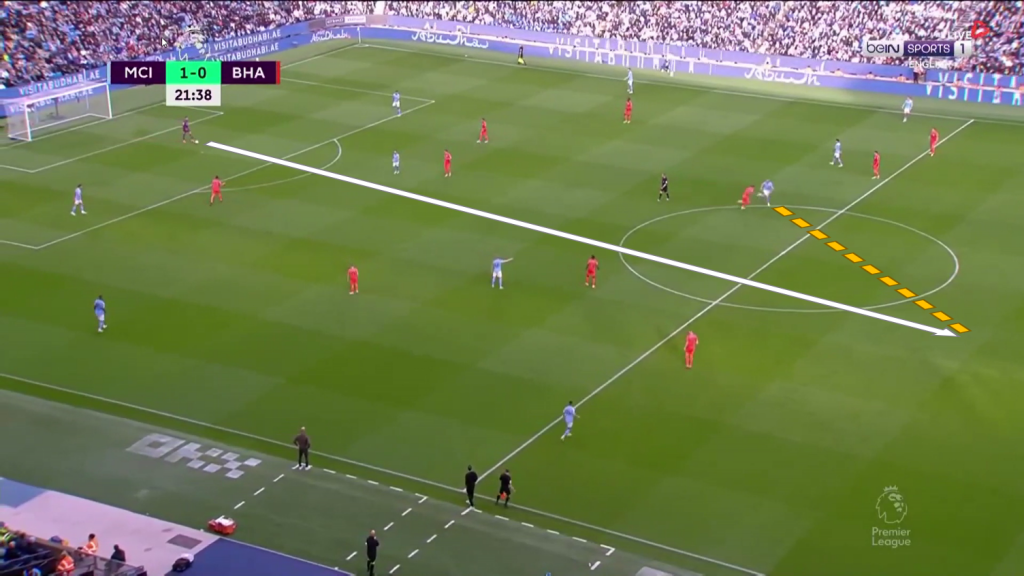
Naturally, Brighton's goalkeeper can't press, so Manchester City has an 11v10 advantage and Ederson is the open player. Ederson uses his advanced-pass technique to deliver a great pass to the space behind the defence. Haaland uses his speed to get past the goalkeeper and score
As can be seen, Manchester City is a team that has mastered analyzing their opponent and using their tactics to their own advantage. Their ability to do this during the match and always having a Plan B puts pressure on the opponent to come up with new solutions.
Borussıa Dortmund 0-0 Manchester Cıty / 25.10.2022
Despite finishing first in their Champions League group, Manchester City struggled in both of their matches against Borussia Dortmund. Manchester City had difficulty breaking through the opponent's 4-5-1/5-4-1 middle third defence, but perhaps had their most dominant period in the second half of the second match, thanks to the changes made by Guardiola. In these 45 minutes, Manchester City narrowly missed out on 3 points from the away match after missing a penalty. So, what was the difference between the first half and the second half? What changes did Guardiola make?

Manchester City started the match with double strikers, with a 3-2-5 formation with Cancelo advancing to the front line, Stones moving inward and Ilkay standing next to Rodri. In order to prevent a numerical advantage, K. Adeyemi sometimes followed Cancelo all the way deep, and Dortmund changed from a 4-5-1 formation to a 5-4-1 at these times.
Foden comes inward, opening up space for Cancelo on the wing. With Adeyemi comes deep to cover the space, Dortmund forms a 5-4-1 formation and prevents Manchester City's attempts to gain a numerical advantage in the final third

However, this structure chosen by Edin Terzic also has natural disadvantages. Although Dortmund's crowded midfield prevented Manchester City from easily penetrating from the center, the lack of forwards in the front line gave the centre-backs of Manchester City plenty of time and space. Moukoko couldn't press the three centre-backs alone, so Manchester City's centre-backs were able to easily play the ball out from the back throughout the match. The question here is who these passes should go to, and Guardiola, who knows the answer, took control of the situation with the changes he made in the second half.


In some situations where Süle positioned himself in the center, Adeyemi did not follow Cancelo. For this reason, Cancelo often received the ball in dangerous areas in the first half
Süle's positioning in the center was not a coincidence. Phil Foden attracted Süle's attention and then moved towards the center, pinning Süle in the center. At these times, Cancelo, aware of the open space, continually made runs behind the defence. Adeyemi also not following allowed for the same situation to occur frequently in the first half

The same action once again. Foden and Süle are inside, with Adeyemi not in a position to follow a potential through pass. What stands out is Ake having wide open space. As mentioned above, this is a result of the pressing style chosen by Dortmund

Although Manchester City often found Cancelo with the ball in dangerous areas, Cancelo was unable to effectively utilize these positions. Because he is right-footed, when the ball came to him he had to slow it down, which caused Adeyemi to catch up to him and close the gap. Guardiola noticed this and made two changes, placing the left-footed and faster Phil Foden in that position and ensuring that the tempo did not drop when through passes were made. This way, when the ball reached the final third, the attack did not slow down.

In the second half, the lineups were as follows:
Manchester City turned to a 4-3-3 formation with two substitutions, while Borussia Dortmund made no changes

While the 3-2-5 formation did not change, the roles of the players did. Stones moved to right full-back while playing next to Rodri, and İlkay began to position himself in half-space like Bernardo. Foden, unlike in the first half, found himself playing wider on the wing and consistently making runs behind the defence like Cancelo
In this situation, it is also clear that Bernardo, who is strong on his left foot like Foden, occasionally positions himself on the wing. In these moments, Foden is responsible for manipulating Süle in half-space as he did in the first half


Before Mahrez's missed penalty, the reasons for the player changes in the second half are more apparent. As Süle goes higher to defend Bernardo, who has the ball, a gap is created behind the defensive line as shown by Belingham's hand. Adeyemi, like in the first half, does not scan the field and is slow to recognize the run, while Foden quickly covers the distance to the gap and plays a ball into the penalty area with his strong foot without wasting time. Manchester City wins a penalty from the continuation of the situation
We had mentioned that during the match, Manchester City's defenders had a lot of space and time on the pitch. When they dribble into these areas, another action took place:

In this situation, Ake dribbles forward. Adeyemi, who would normally mark Bernardo, is forced to put pressure on Ake, leaving Bernardo open. As a result of Ake's pass, Bernardo receives the ball on the touchline

Manchester City achieves a 5v4 numerical superiority in the attacking line. Süle leaves his area to go to Bernardo, leaving a large gap in the half-space. Foden makes one of the half-space runs that we are used to seeing from Manchester City's other number 8s and the away team gets a goal scoring chance
As you can see, small details like this determine the result of matches. The preferred foot of a player can be almost as decisive as their physical attributes. The match's momentary tempo can depend on this. Being able to pay attention to this and make the necessary adjustments during the match once again shows how special Manchester City's coaching staff is.
At (Aston) Villa, I was in theory playing on the left, but in matches, I was authorised to change position if I felt it necessary. With Pep (Guardiola), it is different. He tells me to feel free, but in a structured shape, with a precise position on the pitch... With him, if you are a left winger, well then you stay on the left. But obviously you do not complain, because he is the best manager...
The words above belong to Jack Grealish and they explain a lot. If you have noticed from the images of the matches, you will see that each player has predetermined and certain roles. While this is a thing that is opposed by many people, it is actually a very effective system that highlights the positive aspects of the players and hides their negative aspects, as Guardiola has previously said. For example, let's say that our winger is effective in dribbling and have a high ability to beat their opponents. Logically, our aim will be to leave him 1v1 with the opponent's defender. In this way, our winger who has passed the opponent will quickly enter the penalty area and create a goal scoring opportunity for the team. The aim is to create an environment where players can showcase their abilities and hide their weaknesses. This is also the basic logic of the Manchester City team. It is impossible to play this game with players who lack positional discipline. The relationship with the players is very important because they need to be convinced that this game will benefit them. If a player is not convinced, the team's game will be disrupted and the players will not be able to move in harmony. Football legend Thierry Henry, who worked with Guardiola at Barcelona, was one of the players who got into trouble because of this. In the video below, he talks about what happened to him in a match where he did not listen to Guardiola. The fact that Guardiola took him off despite him scoring a goal shows how strict and definite he is on this subject:
Once the players have become disciplined, it becomes the responsibility of the coaching team to analyze the opponent's matches and create a tactic that aligns with it, highlighting the positive aspects of their own players. In a way, the players' responsibilities during the match are reduced and any potential problems that may arise are solved before the match. If things go well, control of the match is taken and superiority is established over the opposing team. This game plan, which minimizes chaos and turns matches into a game of chess, as grandmaster Garry Kasparov says, is what makes Manchester City so special.
Congrats to @ManCity and my friend Pep Guardiola, who collects titles everywhere he goes and is one of the few exceptions to my rule about not comparing other sports to chess. He’s a true Grandmaster!
— Garry Kasparov (@Kasparov63) May 12, 2019
After winning the world championship in 1985, Garry Kasparov, who retained his title in 1986, 1987, 1990, 1993, and 1995, referred to the Manchester City manager as a "Grandmaster," further demonstrating Guardiola's tactical genius.
Conclusıon
Although some people may consider Manchester City's playing style to be slow and boring, it is undeniable that it has proven to be effective, especially in long league marathons. Manchester City, which has won the league several times since Pep Guardiola took over, is now focused on Champions League this season. The Blues, who have never managed to win Europe's biggest trophy, are now looking to end their streak of bad luck. With the addition of Erling Haaland, who has made a brilliant start to the season, Manchester City is once again one of the most ambitious teams in the top of Europe. While they are also competing with Arsenal in the league, both teams have similar playing styles and have been leading the league so far. It is difficult to predict where Guardiola's tactical skills and the high quality of his players will take them at the end of the season, but they will certainly be close to the top.


